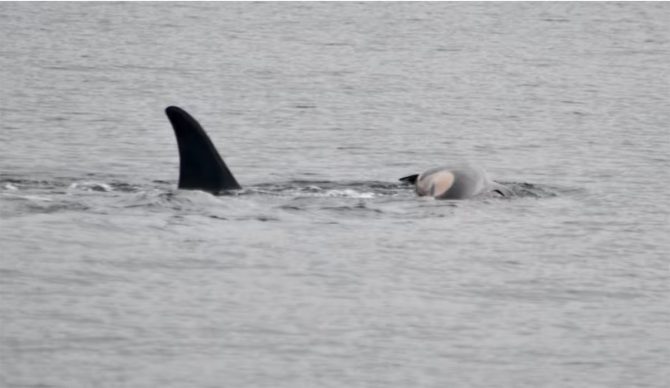
Tahlequah was seen pushing her dead newborn calf, J61, on Jan. 1, 2025. Photo: NOAA Fisheries
In December, news broke that Tahlequah, the orca who famously carried her dead calf for 17 days in 2018, had given birth again. Sadly, it appears that the new calf died as well. Now, the grieving mother is carrying her baby again.
Tahlequah, known formally to scientists as J35, has given birth to four calfs over the years. She is part of a well-researched pod of Southern Resident whales known as the J Pod. Born in 1998, Tahlequah is the matriarch of a sub-group of the J Pod that has a very wide range. They travel between the northwestern United States and southern Canada in the Pacific Ocean, and in the last decade or so, it’s become more and more apparent that they are struggling. Each calf is extraordinarily important to the pod as a whole and as it stands now, the pod is not whole. As of 2018, there were 75 of them, and the prior three years yielded no surviving calfs. A healthy population should number around 300 members.
Tahlequah’s new calf, called J61, was first spotted in December, and it was immediately apparent that neither Tahlequah or her calf were doing well.
“The team, including multiple experienced killer whale researchers, have expressed concern about the calf’s health based on the behavior of both J35 and J61,” the Center for Whale Research (CWR) wrote in a Facebook post. “Early life is always dangerous for new calves, with a very high mortality rate in the first year. J35 is an experienced mother, and we hope that she is able to keep J61 alive through these difficult early days.”
Sadly, it was confirmed on Wednesday that J61 didn’t live. It’s not known exactly what the cause of death was, and it’s unlikely that researchers will be able to find out. Tahlequah is carrying its body with her, making recovery for a necropsy nearly impossible.
“Given that J35 is very attached to it, the likelihood of us being able to recover the calf is fairly low,” Brad Hanson, a research scientist with the National Oceanic and Atmospheric Administration’s Northwest Fisheries Science Center, said in a news conference.
Tahlequah has been seen carrying the dead calf on top of her head, which is worrying researchers.
“That essentially results in a lot more drag,” Hanson explained, “and so her energy expenditure is going to be fairly significant. It is a concern that she was spending a lot of energy to try to take care of this calf that she has lost.”
Thankfully, she does seem to be keeping up with her pod and functioning as a part of the group. In a bit of a silver lining, there does appear to be another newborn orca traveling with the J Pod, and as of this writing, it seems to be healthy. Still, though, the loss of J61 is heartbreaking, given Tahlequah’s tragic history.
Although it may seem obvious to the casual observer, scientists feel confident that Tahlequah is grieving in a similar way to humans, and they’ve got the research to prove it.
“Over the last few years, we realized that we have the same neurotransmitters that they have,” Joe Gaydos, the science director for marine conservation program SeaDoc Society, told the CBC. “I think it’s fair to say from a scientific perspective that they have the same hard wiring, [so] they’re going to have the same emotions.”

